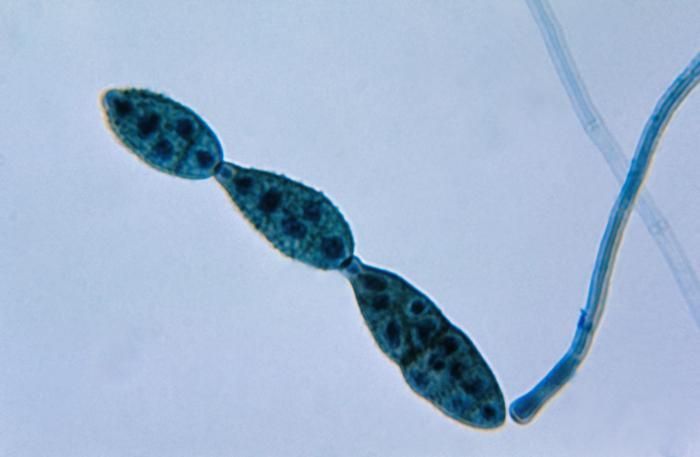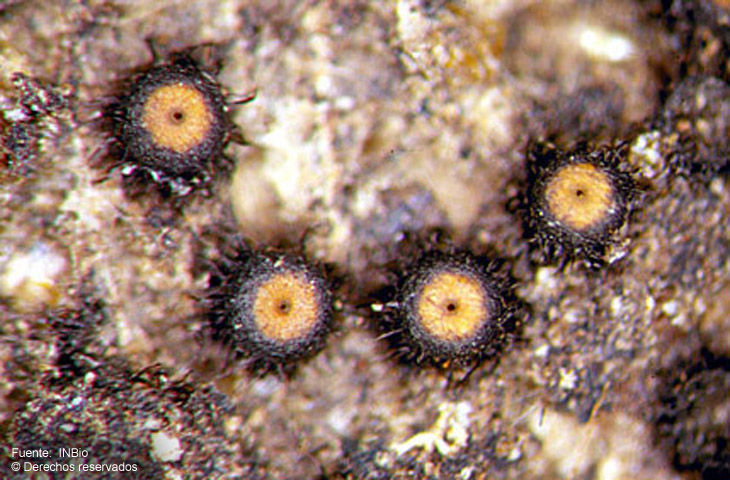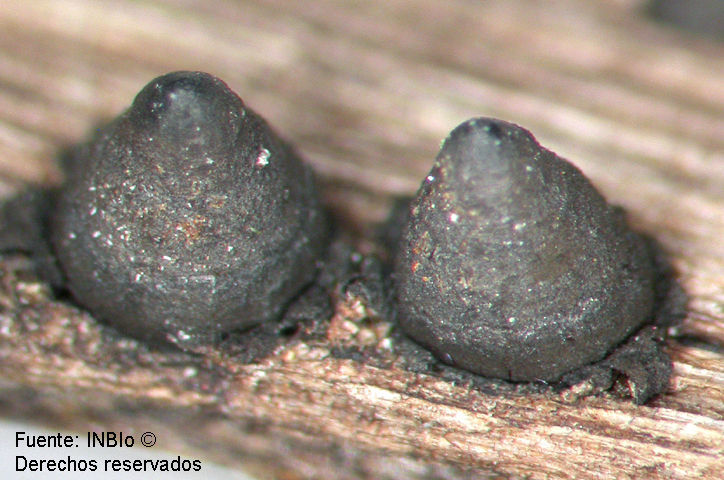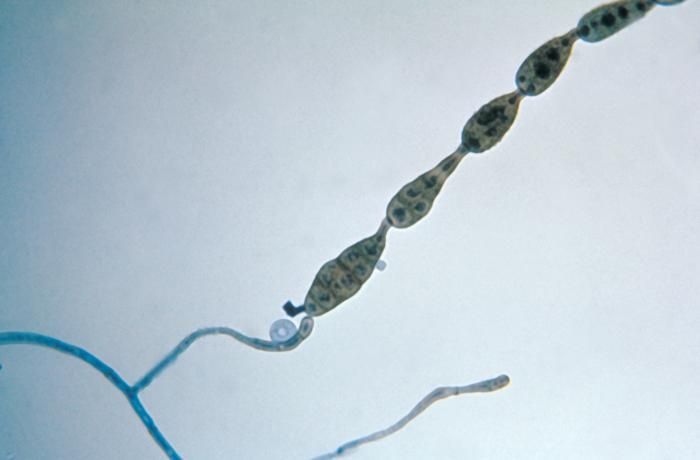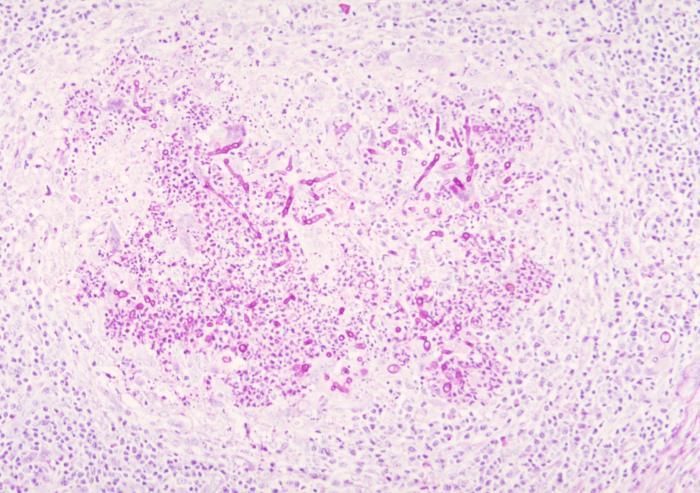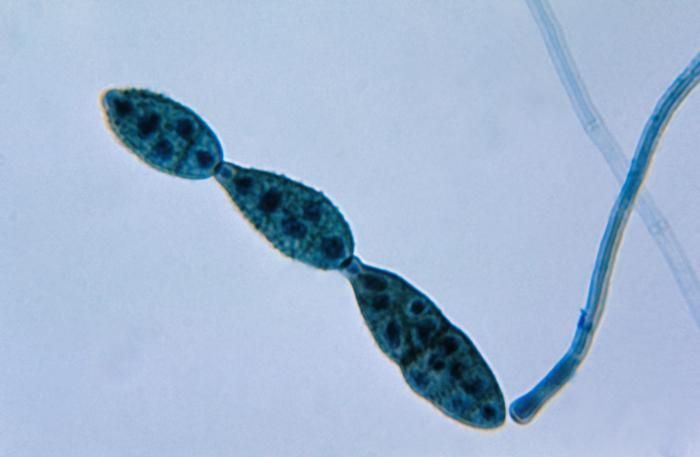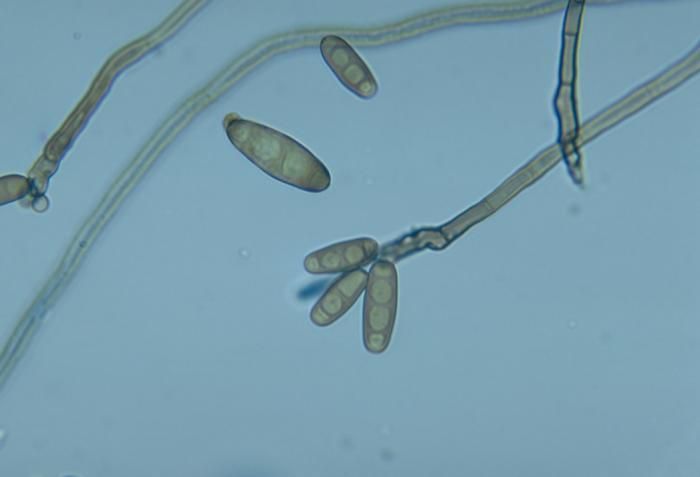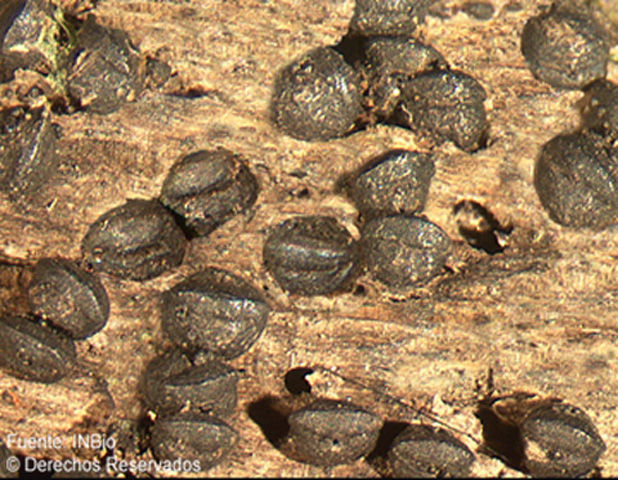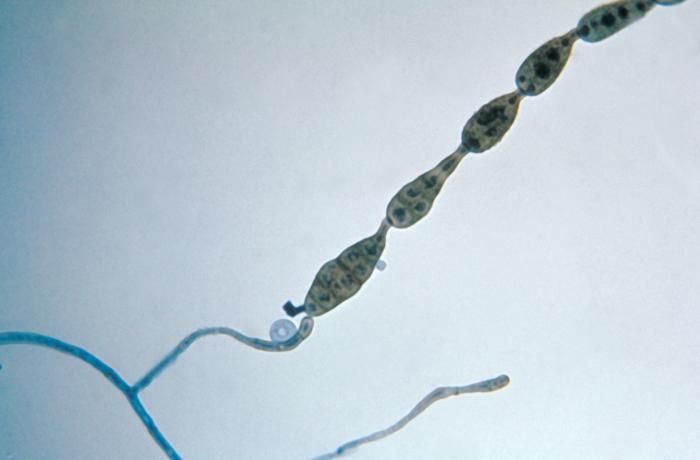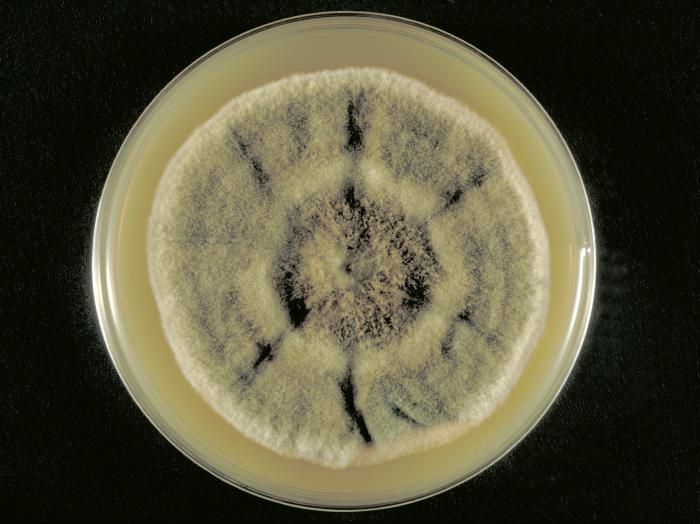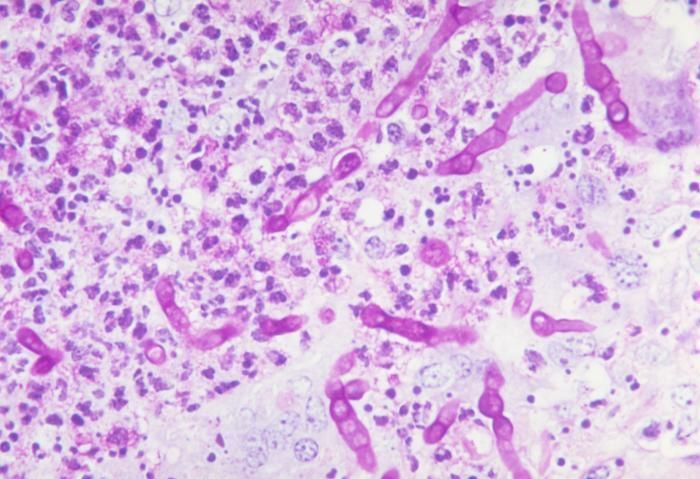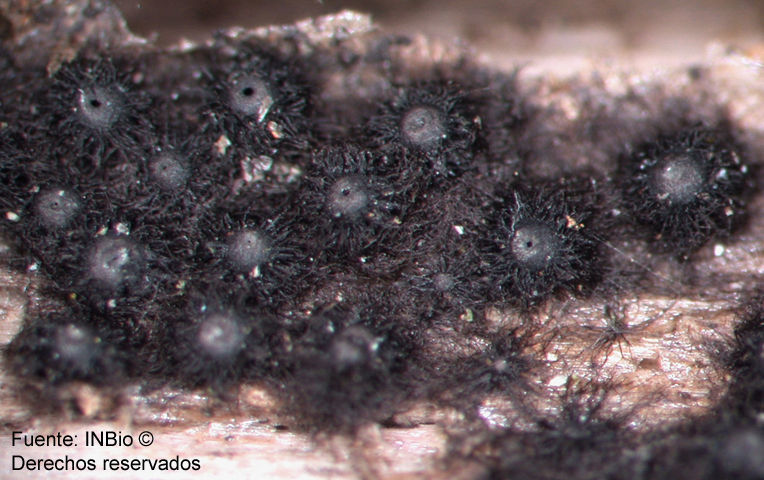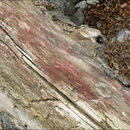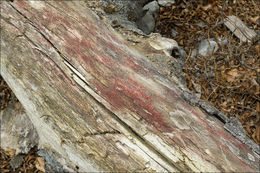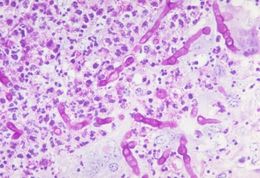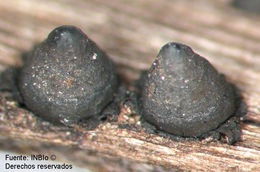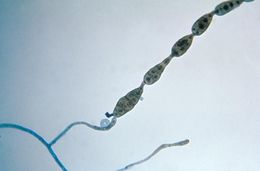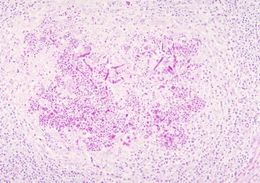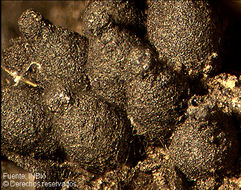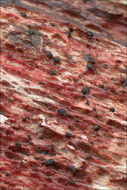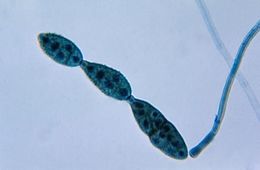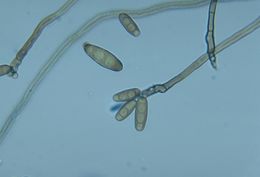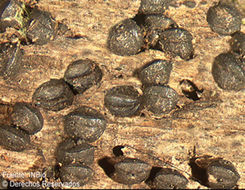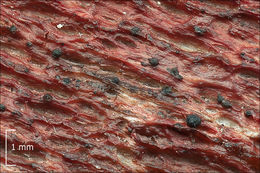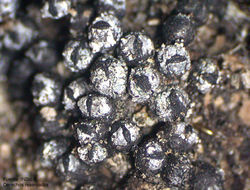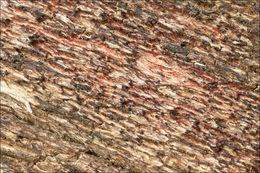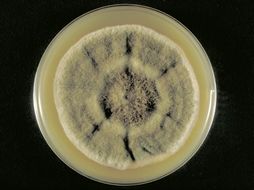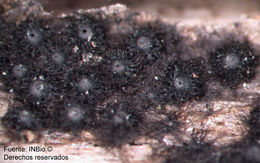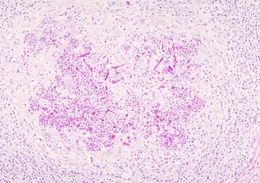-
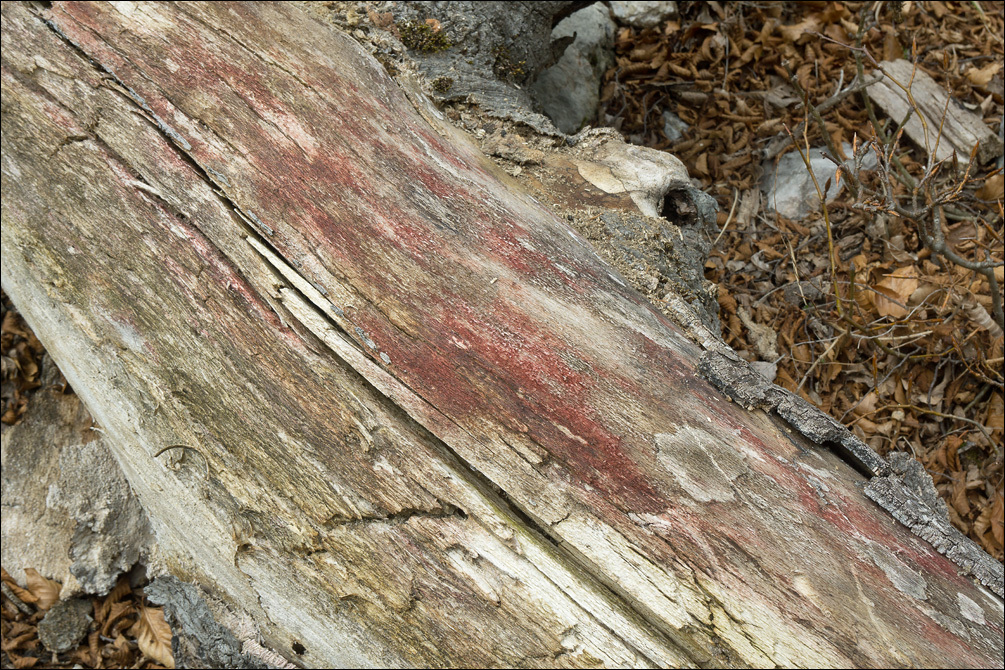
Habitat: : mountain scree slope, southeast aspect; open, sunny, dry place; calcareous ground; exposed to direct rain; elevation 680 m; average temperature 6-8 deg C, average precipitations ~3.000 mm/year; alpine phytogeographical region.Substratum: dead, rotten trunk of Fagus sylvatica lying on ground.Comments: This ascomycete remains a secret for me. It appears to have perithecioid ascomata with occasionally papillate apex, cellular pseudoparaphyses, bitunicate (hope so) and clavate/cylindrical 8-spore asci, ascospores with pigmentation and several septa and peridium composed of a few layers of cells. Thus it possibly belongs to fungi order Pleosporales Luttr. ex M.E. Barr. This order comprises tens of families and thousands of species. I searched for species, which stain decaying wood reddish/purplish. I browsed through short descriptions of about 160 species studied in the paper of Zhang et al. (2009) (Table:1). Several species, which stain substratum reddish, are cited, but none fits to this observation. It is also possible that my assumption about Pleosporales is completely wrong and this find is something totally different. Hard to manage is also the fact that the traditional taxonomy based exclusively on morphology has been overturned drastically by recent molecular studies. Hense proper naming of species (even genera and families) is confusing for an amateur. Unfortunately, there was no response from AscoFrance forum either. Any help would be much appreciated.Spores smooth, septated; from 3 to 7 septa, AVG = 4.5, SD = 0.9, N = 80. Dimensions: 19,4 [24,5 ; 26,5] 31,6 x 5,2 [6 ; 6,3] 7,1 microns; Q = 3,1 [4 ; 4,4] 5,2; N = 40; C = 95%; Me = 25,5 x 6,1 microns; Qe = 4,2. Olympus CH20, NEA 100x/1.25, magnification 1.000 x, oil (asci tip, perithecia wall); NEA 40x/0.65, magnification 400x (spores, asci), in water; fresh material. Novex, Zoom Stereo RZ_Range, Holland (perithecia). AmScope MA500 digital camera.Herbarium: Mycotheca and lichen herbarium (LJU-Li) of Slovenian Forestry Institute, Vena pot 2, Ljubljana, Index Herbariorum LJFRef.:(1) Zhang, Y. et al. Multi-Locus Phylogeny of Pleosporales: A Taxonomic, Ecological and Evolutionary Re-Evaluation. Studies in Mycology 64 (2009): 85102S5. PMC. Web. (accessed: Dec. 30. 2017).(2) http://fungi.myspecies.info/all-fungi/massariosphaeria (accessed Dec. 24. 2017)(3) https://www.asturnatura.com/especie/massariosphaeria-typhicola.html (accessed Dec. 24. 2017)(4) https://www.sites.google.com/site/funghiparadise/home (accessed Dec. 24. 2017)(5) MO Observation 84963
-
This photomicrograph shows a chain of conidia of a Alternaria sp. fungus, which can be a cause of phaeohyphomycosis.Created: 1955
-
This was a case of phaeohyphomycosis of subcutaneous tissue due to the fungus Curvularia harveyi.Created: 1973
-
Instituto Nacional de Biodiversidad - INBio, Costa Rica.
INBio
Peritecios de Byssosphaeria schiedermayeriana (Fuckel) Barr.
-
Instituto Nacional de Biodiversidad - INBio, Costa Rica.
INBio
Cuerpos fructíferos de Astrosphaeriella longispora J.D.Rogers & M. E. Barr.Foto: Loengrin Umaña T.
-
This photomicrograph shows a chain of conidia of a Alternaria sp. fungus, which can be a cause of phaeohyphomycosis.Created: 1955
-
This was a case of phaeohyphomycosis of subcutaneous tissue due to the fungus Curvularia harveyi.Created: 1973
-
Instituto Nacional de Biodiversidad - INBio, Costa Rica.
INBio
Peritecios de Hypsostroma saxicola.Foto: Eduardo Alvarado
-
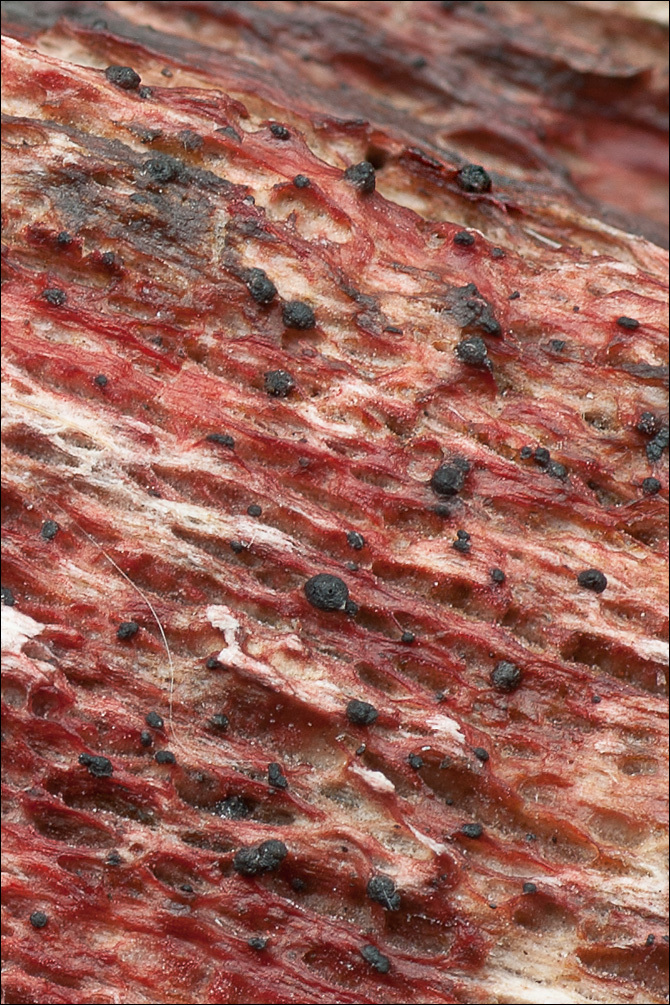
Habitat: : mountain scree slope, southeast aspect; open, sunny, dry place; calcareous ground; exposed to direct rain; elevation 680 m; average temperature 6-8 deg C, average precipitations ~3.000 mm/year; alpine phytogeographical region. Substratum: dead, rotten trunk of Fagus sylvatica lying on ground. Comments: This ascomycete remains a secret for me. It appears to have perithecioid ascomata with occasionally papillate apex, cellular pseudoparaphyses, bitunicate (hope so) and clavate/cylindrical 8-spore asci, ascospores with pigmentation and several septa and peridium composed of a few layers of cells. Thus it possibly belongs to fungi order Pleosporales Luttr. ex M.E. Barr. This order comprises tens of families and thousands of species. I searched for species, which stain decaying wood reddish/purplish. I browsed through short descriptions of about 160 species studied in the paper of Zhang et al. (2009) (Table:1). Several species, which stain substratum reddish, are cited, but none fits to this observation. It is also possible that my assumption about Pleosporales is completely wrong and this find is something totally different. Hard to manage is also the fact that the traditional taxonomy based exclusively on morphology has been overturned drastically by recent molecular studies. Hense proper naming of species (even genera and families) is confusing for an amateur. Unfortunately, there was no response from AscoFrance forum either. Any help would be much appreciated. Spores smooth, septated; from 3 to 7 septa, AVG = 4.5, SD = 0.9, N = 80. Dimensions: 19,4 [24,5 ; 26,5] 31,6 x 5,2 [6 ; 6,3] 7,1 microns; Q = 3,1 [4 ; 4,4] 5,2; N = 40; C = 95%; Me = 25,5 x 6,1 microns; Qe = 4,2. Olympus CH20, NEA 100x/1.25, magnification 1.000 x, oil (asci tip, perithecia wall); NEA 40x/0.65, magnification 400x (spores, asci), in water; fresh material. Novex, Zoom Stereo RZ_Range, Holland (perithecia). AmScope MA500 digital camera. Herbarium: Mycotheca and lichen herbarium (LJU-Li) of Slovenian Forestry Institute, Vena pot 2, Ljubljana, Index Herbariorum LJF Ref.: (1) Zhang, Y. et al. Multi-Locus Phylogeny of Pleosporales: A Taxonomic, Ecological and Evolutionary Re-Evaluation. Studies in Mycology 64 (2009): 85102S5. PMC. Web. (accessed: Dec. 30. 2017). (2) http://fungi.myspecies.info/all-fungi/massariosphaeria (accessed Dec. 24. 2017) (3) https://www.asturnatura.com/especie/massariosphaeria-typhicola.html (accessed Dec. 24. 2017) (4) https://www.sites.google.com/site/funghiparadise/home (accessed Dec. 24. 2017) (5) MO Observation 84963
-
This photomicrograph shows a chain of conidia of a Alternaria sp. fungus, which can be a cause of phaeohyphomycosis.Created: 1955
-
This photomicrograph shows conidiophores and conidia of the fungus Curvularia harveyi.Created: 1973
-
Cuerpos fructíferos de Xenolophium applanatum (Petch)Huhndorf. Foto: Silvia Soto.
-
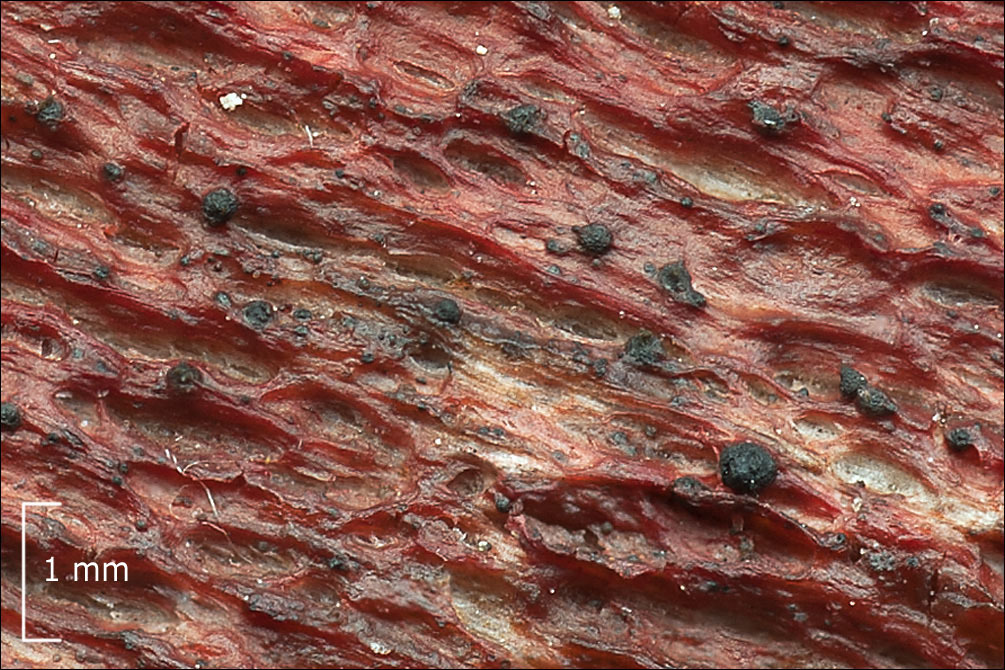
Habitat: : mountain scree slope, southeast aspect; open, sunny, dry place; calcareous ground; exposed to direct rain; elevation 680 m; average temperature 6-8 deg C, average precipitations ~3.000 mm/year; alpine phytogeographical region. Substratum: dead, rotten trunk of Fagus sylvatica lying on ground. Comments: This ascomycete remains a secret for me. It appears to have perithecioid ascomata with occasionally papillate apex, cellular pseudoparaphyses, bitunicate (hope so) and clavate/cylindrical 8-spore asci, ascospores with pigmentation and several septa and peridium composed of a few layers of cells. Thus it possibly belongs to fungi order Pleosporales Luttr. ex M.E. Barr. This order comprises tens of families and thousands of species. I searched for species, which stain decaying wood reddish/purplish. I browsed through short descriptions of about 160 species studied in the paper of Zhang et al. (2009) (Table:1). Several species, which stain substratum reddish, are cited, but none fits to this observation. It is also possible that my assumption about Pleosporales is completely wrong and this find is something totally different. Hard to manage is also the fact that the traditional taxonomy based exclusively on morphology has been overturned drastically by recent molecular studies. Hense proper naming of species (even genera and families) is confusing for an amateur. Unfortunately, there was no response from AscoFrance forum either. Any help would be much appreciated. Spores smooth, septated; from 3 to 7 septa, AVG = 4.5, SD = 0.9, N = 80. Dimensions: 19,4 [24,5 ; 26,5] 31,6 x 5,2 [6 ; 6,3] 7,1 microns; Q = 3,1 [4 ; 4,4] 5,2; N = 40; C = 95%; Me = 25,5 x 6,1 microns; Qe = 4,2. Olympus CH20, NEA 100x/1.25, magnification 1.000 x, oil (asci tip, perithecia wall); NEA 40x/0.65, magnification 400x (spores, asci), in water; fresh material. Novex, Zoom Stereo RZ_Range, Holland (perithecia). AmScope MA500 digital camera. Herbarium: Mycotheca and lichen herbarium (LJU-Li) of Slovenian Forestry Institute, Vena pot 2, Ljubljana, Index Herbariorum LJF Ref.: (1) Zhang, Y. et al. Multi-Locus Phylogeny of Pleosporales: A Taxonomic, Ecological and Evolutionary Re-Evaluation. Studies in Mycology 64 (2009): 85102S5. PMC. Web. (accessed: Dec. 30. 2017). (2) http://fungi.myspecies.info/all-fungi/massariosphaeria (accessed Dec. 24. 2017) (3) https://www.asturnatura.com/especie/massariosphaeria-typhicola.html (accessed Dec. 24. 2017) (4) https://www.sites.google.com/site/funghiparadise/home (accessed Dec. 24. 2017) (5) MO Observation 84963
-
This photomicrograph shows a chain of conidia of a Alternaria sp. fungus, which can be a cause of phaeohyphomycosis.Created: 1955
-
This photomicrograph shows conidiophores and conidia of the fungus Curvularia harveyi.Created: 1973
-
Ascomas de Ostropella albocincta (Berk. & Curt.) von Hohnel Foto: Loengrin Umaña.
-
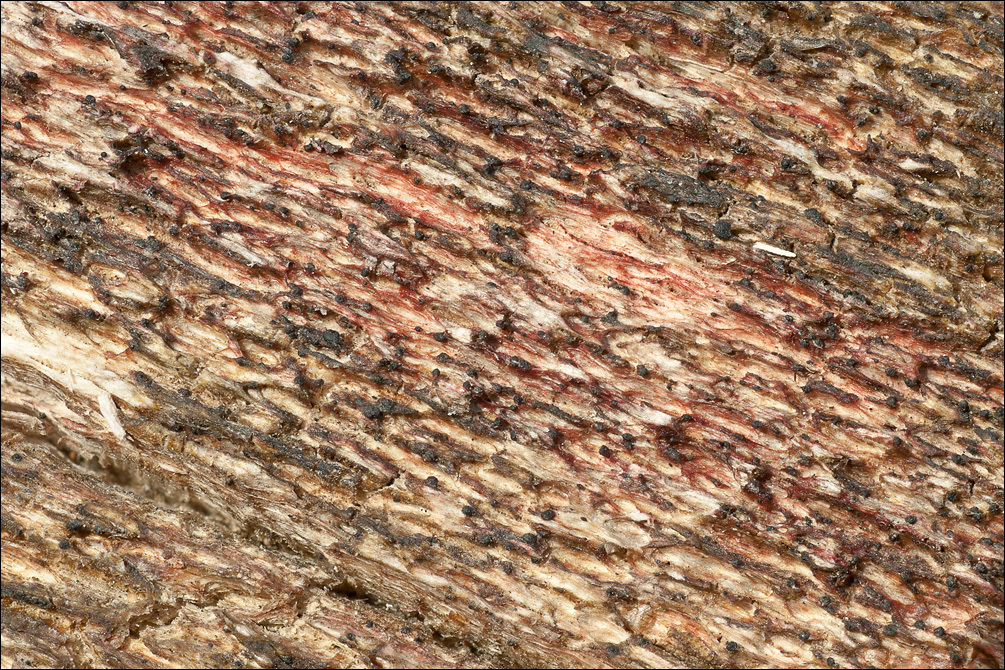
Habitat: : mountain scree slope, southeast aspect; open, sunny, dry place; calcareous ground; exposed to direct rain; elevation 680 m; average temperature 6-8 deg C, average precipitations ~3.000 mm/year; alpine phytogeographical region. Substratum: dead, rotten trunk of Fagus sylvatica lying on ground. Comments: This ascomycete remains a secret for me. It appears to have perithecioid ascomata with occasionally papillate apex, cellular pseudoparaphyses, bitunicate (hope so) and clavate/cylindrical 8-spore asci, ascospores with pigmentation and several septa and peridium composed of a few layers of cells. Thus it possibly belongs to fungi order Pleosporales Luttr. ex M.E. Barr. This order comprises tens of families and thousands of species. I searched for species, which stain decaying wood reddish/purplish. I browsed through short descriptions of about 160 species studied in the paper of Zhang et al. (2009) (Table:1). Several species, which stain substratum reddish, are cited, but none fits to this observation. It is also possible that my assumption about Pleosporales is completely wrong and this find is something totally different. Hard to manage is also the fact that the traditional taxonomy based exclusively on morphology has been overturned drastically by recent molecular studies. Hense proper naming of species (even genera and families) is confusing for an amateur. Unfortunately, there was no response from AscoFrance forum either. Any help would be much appreciated. Spores smooth, septated; from 3 to 7 septa, AVG = 4.5, SD = 0.9, N = 80. Dimensions: 19,4 [24,5 ; 26,5] 31,6 x 5,2 [6 ; 6,3] 7,1 microns; Q = 3,1 [4 ; 4,4] 5,2; N = 40; C = 95%; Me = 25,5 x 6,1 microns; Qe = 4,2. Olympus CH20, NEA 100x/1.25, magnification 1.000 x, oil (asci tip, perithecia wall); NEA 40x/0.65, magnification 400x (spores, asci), in water; fresh material. Novex, Zoom Stereo RZ_Range, Holland (perithecia). AmScope MA500 digital camera. Herbarium: Mycotheca and lichen herbarium (LJU-Li) of Slovenian Forestry Institute, Vena pot 2, Ljubljana, Index Herbariorum LJF Ref.: (1) Zhang, Y. et al. Multi-Locus Phylogeny of Pleosporales: A Taxonomic, Ecological and Evolutionary Re-Evaluation. Studies in Mycology 64 (2009): 85102S5. PMC. Web. (accessed: Dec. 30. 2017). (2) http://fungi.myspecies.info/all-fungi/massariosphaeria (accessed Dec. 24. 2017) (3) https://www.asturnatura.com/especie/massariosphaeria-typhicola.html (accessed Dec. 24. 2017) (4) https://www.sites.google.com/site/funghiparadise/home (accessed Dec. 24. 2017) (5) MO Observation 84963
-
This was a Sabourauds dextrose agar plate culture growing the fungus Curvularia harveyi.Created: 1973
-
Fernando A. Fernández.
INBio
Cuerpos fructíferos de Ostropella striata Huhndorf. Foto: Fernando A. Fernández.
-
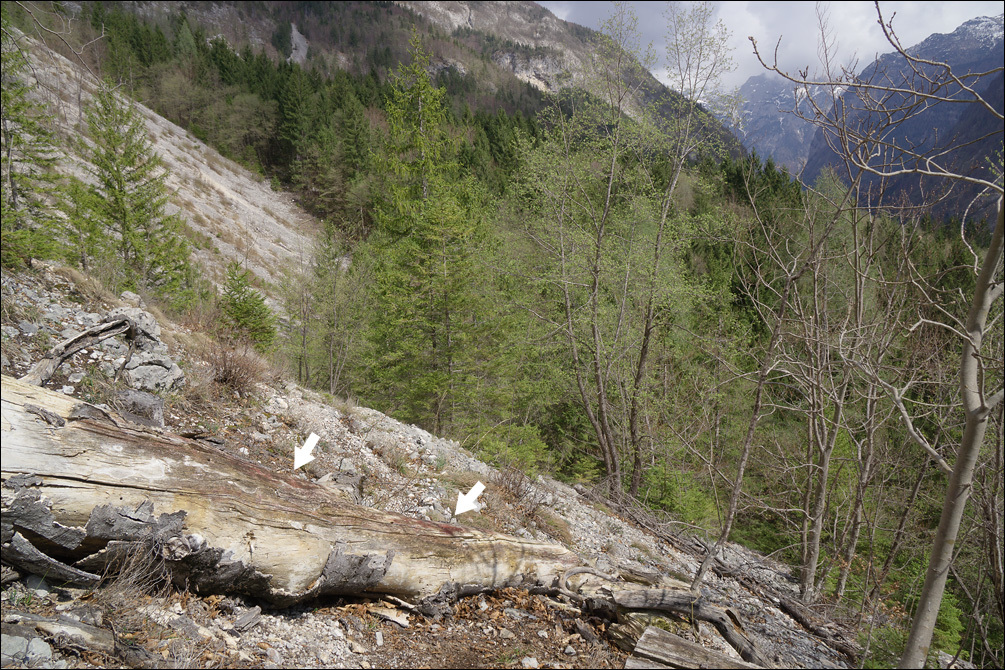
Habitat: : mountain scree slope, southeast aspect; open, sunny, dry place; calcareous ground; exposed to direct rain; elevation 680 m; average temperature 6-8 deg C, average precipitations ~3.000 mm/year; alpine phytogeographical region. Substratum: dead, rotten trunk of Fagus sylvatica lying on ground. Comments: This ascomycete remains a secret for me. It appears to have perithecioid ascomata with occasionally papillate apex, cellular pseudoparaphyses, bitunicate (hope so) and clavate/cylindrical 8-spore asci, ascospores with pigmentation and several septa and peridium composed of a few layers of cells. Thus it possibly belongs to fungi order Pleosporales Luttr. ex M.E. Barr. This order comprises tens of families and thousands of species. I searched for species, which stain decaying wood reddish/purplish. I browsed through short descriptions of about 160 species studied in the paper of Zhang et al. (2009) (Table:1). Several species, which stain substratum reddish, are cited, but none fits to this observation. It is also possible that my assumption about Pleosporales is completely wrong and this find is something totally different. Hard to manage is also the fact that the traditional taxonomy based exclusively on morphology has been overturned drastically by recent molecular studies. Hense proper naming of species (even genera and families) is confusing for an amateur. Unfortunately, there was no response from AscoFrance forum either. Any help would be much appreciated. Spores smooth, septated; from 3 to 7 septa, AVG = 4.5, SD = 0.9, N = 80. Dimensions: 19,4 [24,5 ; 26,5] 31,6 x 5,2 [6 ; 6,3] 7,1 microns; Q = 3,1 [4 ; 4,4] 5,2; N = 40; C = 95%; Me = 25,5 x 6,1 microns; Qe = 4,2. Olympus CH20, NEA 100x/1.25, magnification 1.000 x, oil (asci tip, perithecia wall); NEA 40x/0.65, magnification 400x (spores, asci), in water; fresh material. Novex, Zoom Stereo RZ_Range, Holland (perithecia). AmScope MA500 digital camera. Herbarium: Mycotheca and lichen herbarium (LJU-Li) of Slovenian Forestry Institute, Vena pot 2, Ljubljana, Index Herbariorum LJF Ref.: (1) Zhang, Y. et al. Multi-Locus Phylogeny of Pleosporales: A Taxonomic, Ecological and Evolutionary Re-Evaluation. Studies in Mycology 64 (2009): 85102S5. PMC. Web. (accessed: Dec. 30. 2017). (2) http://fungi.myspecies.info/all-fungi/massariosphaeria (accessed Dec. 24. 2017) (3) https://www.asturnatura.com/especie/massariosphaeria-typhicola.html (accessed Dec. 24. 2017) (4) https://www.sites.google.com/site/funghiparadise/home (accessed Dec. 24. 2017) (5) MO Observation 84963
-
This was a case of phaeohyphomycosis of subcutaneous tissue due to the fungus Curvularia harveyi.Created: 1973
-
Cuerpos fructíferos de Byssosphaeria jamaicana (Sivan.) M.E. Barr. Foto: Loengrin Umaña
-
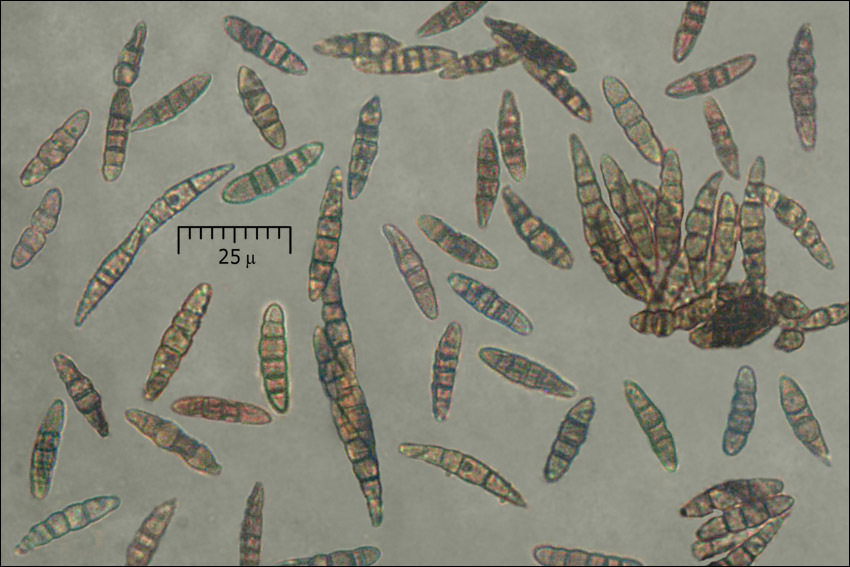
Habitat: : mountain scree slope, southeast aspect; open, sunny, dry place; calcareous ground; exposed to direct rain; elevation 680 m; average temperature 6-8 deg C, average precipitations ~3.000 mm/year; alpine phytogeographical region. Substratum: dead, rotten trunk of Fagus sylvatica lying on ground. Comments: This ascomycete remains a secret for me. It appears to have perithecioid ascomata with occasionally papillate apex, cellular pseudoparaphyses, bitunicate (hope so) and clavate/cylindrical 8-spore asci, ascospores with pigmentation and several septa and peridium composed of a few layers of cells. Thus it possibly belongs to fungi order Pleosporales Luttr. ex M.E. Barr. This order comprises tens of families and thousands of species. I searched for species, which stain decaying wood reddish/purplish. I browsed through short descriptions of about 160 species studied in the paper of Zhang et al. (2009) (Table:1). Several species, which stain substratum reddish, are cited, but none fits to this observation. It is also possible that my assumption about Pleosporales is completely wrong and this find is something totally different. Hard to manage is also the fact that the traditional taxonomy based exclusively on morphology has been overturned drastically by recent molecular studies. Hense proper naming of species (even genera and families) is confusing for an amateur. Unfortunately, there was no response from AscoFrance forum either. Any help would be much appreciated. Spores smooth, septated; from 3 to 7 septa, AVG = 4.5, SD = 0.9, N = 80. Dimensions: 19,4 [24,5 ; 26,5] 31,6 x 5,2 [6 ; 6,3] 7,1 microns; Q = 3,1 [4 ; 4,4] 5,2; N = 40; C = 95%; Me = 25,5 x 6,1 microns; Qe = 4,2. Olympus CH20, NEA 100x/1.25, magnification 1.000 x, oil (asci tip, perithecia wall); NEA 40x/0.65, magnification 400x (spores, asci), in water; fresh material. Novex, Zoom Stereo RZ_Range, Holland (perithecia). AmScope MA500 digital camera. Herbarium: Mycotheca and lichen herbarium (LJU-Li) of Slovenian Forestry Institute, Vena pot 2, Ljubljana, Index Herbariorum LJF Ref.: (1) Zhang, Y. et al. Multi-Locus Phylogeny of Pleosporales: A Taxonomic, Ecological and Evolutionary Re-Evaluation. Studies in Mycology 64 (2009): 85102S5. PMC. Web. (accessed: Dec. 30. 2017). (2) http://fungi.myspecies.info/all-fungi/massariosphaeria (accessed Dec. 24. 2017) (3) https://www.asturnatura.com/especie/massariosphaeria-typhicola.html (accessed Dec. 24. 2017) (4) https://www.sites.google.com/site/funghiparadise/home (accessed Dec. 24. 2017) (5) MO Observation 84963
-
This was a case of phaeohyphomycosis of subcutaneous tissue due to the fungus Curvularia harveyi.Created: 1973


